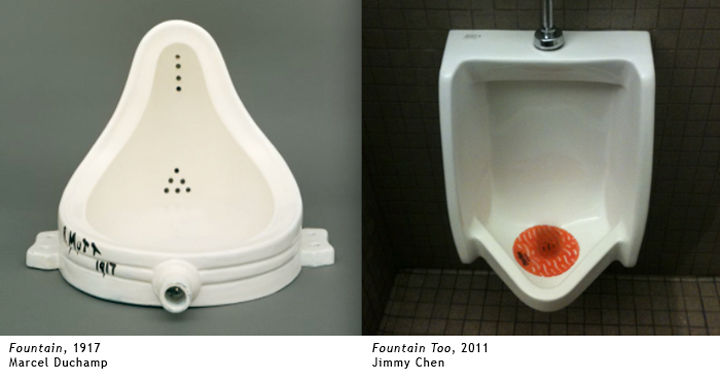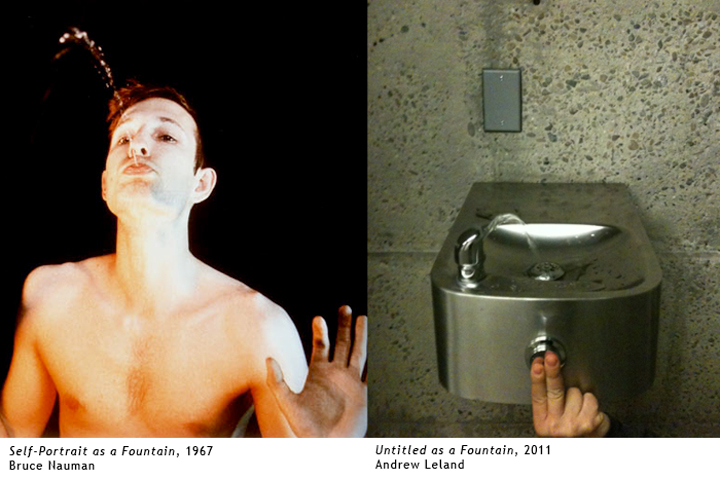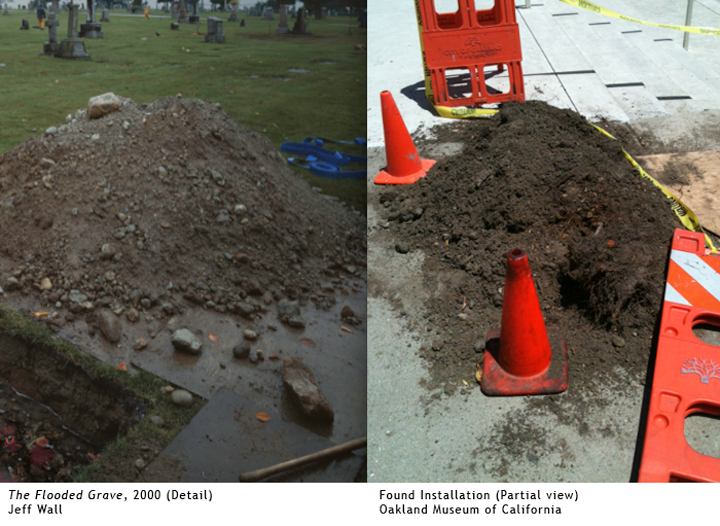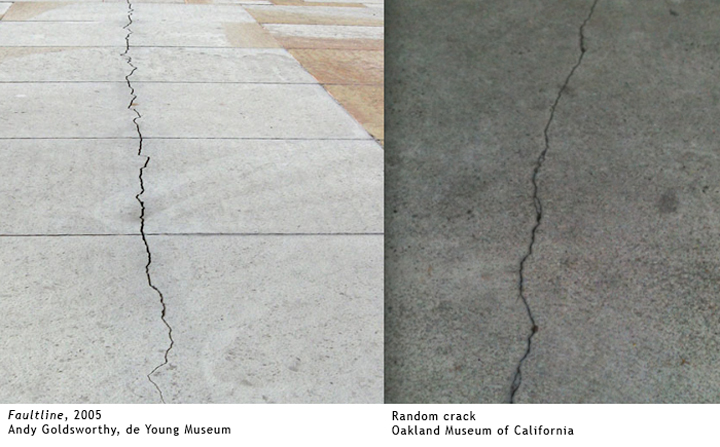
The Inadvertent Curator
Museums around the world hold replicas of Duchamp's Fountain (1917) in their collections. While I felt doubtful that I'd find one at the Oakland Museum of California, I was certain I'd find at least some sort of urinal, which, after the long BART ride, I happened to need desperately. At 11:03 a.m., on a Sunday morning about three weeks ago, I bought my ticket, affixed the orange admission sticker above my right nipple, and immediately got lost.
 I eventually found myself in the men's room near the museum's Blue Oak Café, where "American Standard" took the place of Duchamp's pseudonymous signature, "R. Mutt 1917" on the porcelain—both unabashed assertions of ownership. Some readers may know Pierre Pinoncelli, the seventy-seven-year-old French Neo-Dada performance artist who urinated into Duchamp's Fountain in 2006 at the Centre Pompidou and then, a few years later, struck it with a hammer. An optimist might believe Duchamp would have seen the humor in this act of violence. Optimism isn't a bad thing.
I eventually found myself in the men's room near the museum's Blue Oak Café, where "American Standard" took the place of Duchamp's pseudonymous signature, "R. Mutt 1917" on the porcelain—both unabashed assertions of ownership. Some readers may know Pierre Pinoncelli, the seventy-seven-year-old French Neo-Dada performance artist who urinated into Duchamp's Fountain in 2006 at the Centre Pompidou and then, a few years later, struck it with a hammer. An optimist might believe Duchamp would have seen the humor in this act of violence. Optimism isn't a bad thing.
 Bruce Nauman's Self-portrait as a Fountain (1967) is a reference to the history of self-portrait painting—and to Duchamp's seminal work. The appropriation is strictly semantic. Nauman uses the word "fountain" in the title as his sole reference point, though one may notice how the soft sloping contour of the artist's shoulder mimes the urinal's shape. The clean, utilitarian aesthetic of modernist sculpture borrows from the visual vocabulary of mass production, and museum "amenities" tucked away in the back—drinking fountains, fire hose valves, sleek shiny benches—feel like rogue art installations. The readymade effect is strengthened by the fact that museums are likely to install modern-looking pieces with that default modern sophisticated look. Every object wants to be in a museum, even things that are already inside. I asked my chaperone, Andrew Leland, if he might like to present, as editor-in-residence of this blog, a commissioned-by-me Fountain, exclusively for the OMCA's collection. They should expect the bill shortly.
Bruce Nauman's Self-portrait as a Fountain (1967) is a reference to the history of self-portrait painting—and to Duchamp's seminal work. The appropriation is strictly semantic. Nauman uses the word "fountain" in the title as his sole reference point, though one may notice how the soft sloping contour of the artist's shoulder mimes the urinal's shape. The clean, utilitarian aesthetic of modernist sculpture borrows from the visual vocabulary of mass production, and museum "amenities" tucked away in the back—drinking fountains, fire hose valves, sleek shiny benches—feel like rogue art installations. The readymade effect is strengthened by the fact that museums are likely to install modern-looking pieces with that default modern sophisticated look. Every object wants to be in a museum, even things that are already inside. I asked my chaperone, Andrew Leland, if he might like to present, as editor-in-residence of this blog, a commissioned-by-me Fountain, exclusively for the OMCA's collection. They should expect the bill shortly.
 There's a kind of bleak verity to Jeff Wall's work, the shadows absorbed by the Pacific Northwest, prosaic subjects tinted with elements of the surreal. His photographs are usually digital montages of staged scenes, presented in elaborately produced and installed light-boxes. In The Flooded Grave, a pit, perhaps forgotten for a day or two, fills with sea urchins and anemone in an undersea scene. I found a similar pile of dirt in the Museum's gardens, no doubt a project on hold, cordoned off with strands of cautionary tape. At some pseudo-philosophically baked point in every college kid's career, the student will ask themselves, or a befuddled roommate, "what is real?" This is an effect that art still manages to summon in me. Jeff Wall uses real materials to build artifice, but he presents such artifice with an allegedly objective journalistic flatness. He then shows the work in institutional settings such as galleries and museums. I take a photo of a real situation—presumably a gardening problem of some sort, in which a large pile of soil has been set to a side and marked off like a car accident—and the results are nearly the same as Jeff Wall's, for his calculated conceit portrays the world at large. In the fake's ascent towards the real, real just needs to be.
There's a kind of bleak verity to Jeff Wall's work, the shadows absorbed by the Pacific Northwest, prosaic subjects tinted with elements of the surreal. His photographs are usually digital montages of staged scenes, presented in elaborately produced and installed light-boxes. In The Flooded Grave, a pit, perhaps forgotten for a day or two, fills with sea urchins and anemone in an undersea scene. I found a similar pile of dirt in the Museum's gardens, no doubt a project on hold, cordoned off with strands of cautionary tape. At some pseudo-philosophically baked point in every college kid's career, the student will ask themselves, or a befuddled roommate, "what is real?" This is an effect that art still manages to summon in me. Jeff Wall uses real materials to build artifice, but he presents such artifice with an allegedly objective journalistic flatness. He then shows the work in institutional settings such as galleries and museums. I take a photo of a real situation—presumably a gardening problem of some sort, in which a large pile of soil has been set to a side and marked off like a car accident—and the results are nearly the same as Jeff Wall's, for his calculated conceit portrays the world at large. In the fake's ascent towards the real, real just needs to be.
 Let me end with a beginning. The de Young Museum commissioned Andy Goldsworthy to render a line, a series of carefully constructed cracks in the pavement, to coax patrons from the museum's sidewalk through its front doors. It's an extremely long line, and the DMV would be wise to offer Goldsworthy a similar commission. With an austere faith in art, I followed the crack, my head bowed in piety, and walked directly into a wall.
Let me end with a beginning. The de Young Museum commissioned Andy Goldsworthy to render a line, a series of carefully constructed cracks in the pavement, to coax patrons from the museum's sidewalk through its front doors. It's an extremely long line, and the DMV would be wise to offer Goldsworthy a similar commission. With an austere faith in art, I followed the crack, my head bowed in piety, and walked directly into a wall.
At the beginning of my visit, I'd gone to the Museum café and bought a black-bean-and-roasted-corn salad. I ate it with one of those biodegradable forks made entirely with corn. Using my corn fork to fork corn into my face felt ultra-contemporary. Art doesn't need an argument. It just needs two eyes, a small brain, and a bit of gratitude. Museums are the modern churches, and its patrons are searching for something whose greatness relies on its very evasiveness. As for the canvases inside the gallery, they hung with a reticence borrowed from their creators. A simple dab of paint could mean the sun's effect on an entire field, off in the distance. The day it was painted, like this one, must have been good.
Projects








